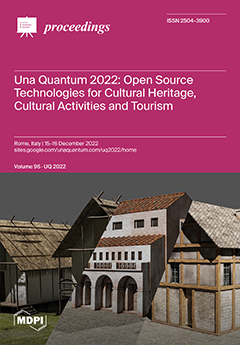Need Help?
Proceedings, 2024, UQ 2022
Una Quantum 2022: Open Source Technologies for Cultural Heritage, Cultural Activities and Tourism
Rome, Italy | 15–16 December 2022
Volume Editors:
Gabriele Ciccone, University of Rome Tor Vergata, Italy
Giuseppe Guarino, University of Bologna, Italy
- Issues are regarded as officially published after their release is announced to the table of contents alert mailing list.
- You may sign up for e-mail alerts to receive table of contents of newly released issues.
- PDF is the official format for papers published in both, html and pdf forms. To view the papers in pdf format, click on the "PDF Full-text" link, and use the free Adobe Reader to open them.
Cover Story (view full-size image):
On 15 and 16 December 2022, the Sala della Fortuna of the National Etruscan Museum at Villa Giulia in Rome hosted the second edition of the conference Una Quantum 2022: Open Source Technologies for
[...] Read more.
On 15 and 16 December 2022, the Sala della Fortuna of the National Etruscan Museum at Villa Giulia in Rome hosted the second edition of the conference Una Quantum 2022: Open Source Technologies for Cultural Heritage, Cultural Activities and Tourism. The conference was funded by the DGERIC of the Italian Ministry of Culture and focused on innovation in cultural heritage management, aligning with Una Quantum's ten-year mission. The event was divided into four thematic sessions led by industry experts in the field, explored historical, artistic, and cultural heritage aspects, culminating in 19 published articles.
Previous Issue
Next Issue
Issue View Metrics
Multiple requests from the same IP address are counted as one view.



